Comprehensive Analysis: Theories, Models, and Principles in E&T
VerifiedAdded on 2020/10/05
|25
|8358
|457
Report
AI Summary
This report delves into various theories, models, and principles relevant to education and training (E&T). It begins by analyzing reflection and evaluation models, including Gibbs' and Kolb's models, and their application in reviewing practice. The report then examines learning theories like behaviorism, cognitivism, and humanism, alongside models of learning preferences, explaining their application in teaching and promoting inclusive learning environments. Furthermore, it explores communication, assessment theories, and curriculum models, providing insights into their practical application in education. The report concludes with reflective journals, synthesizing the learning outcomes and implications of these theories and models within the context of E&T.
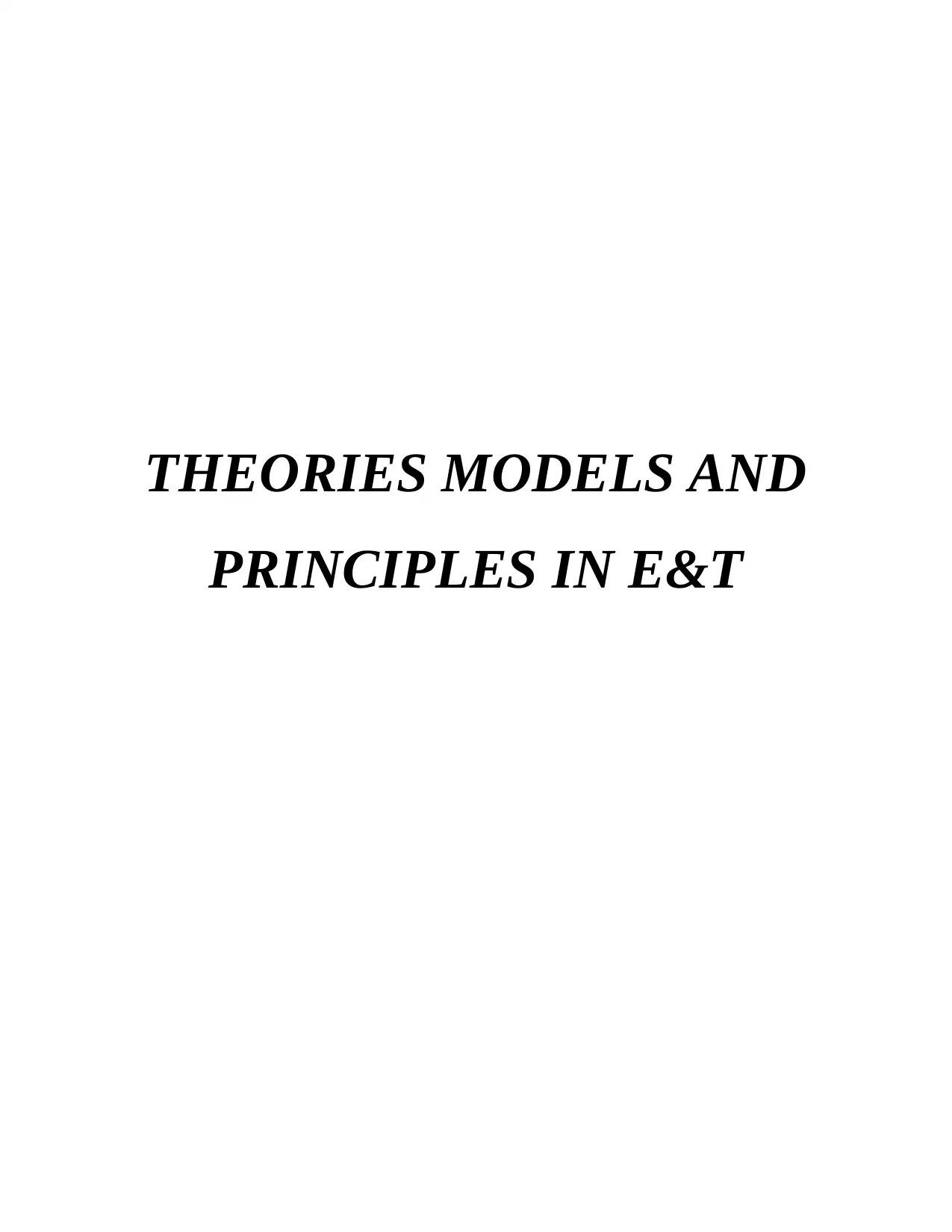
THEORIES MODELS AND
PRINCIPLES IN E&T
PRINCIPLES IN E&T
Paraphrase This Document
Need a fresh take? Get an instant paraphrase of this document with our AI Paraphraser
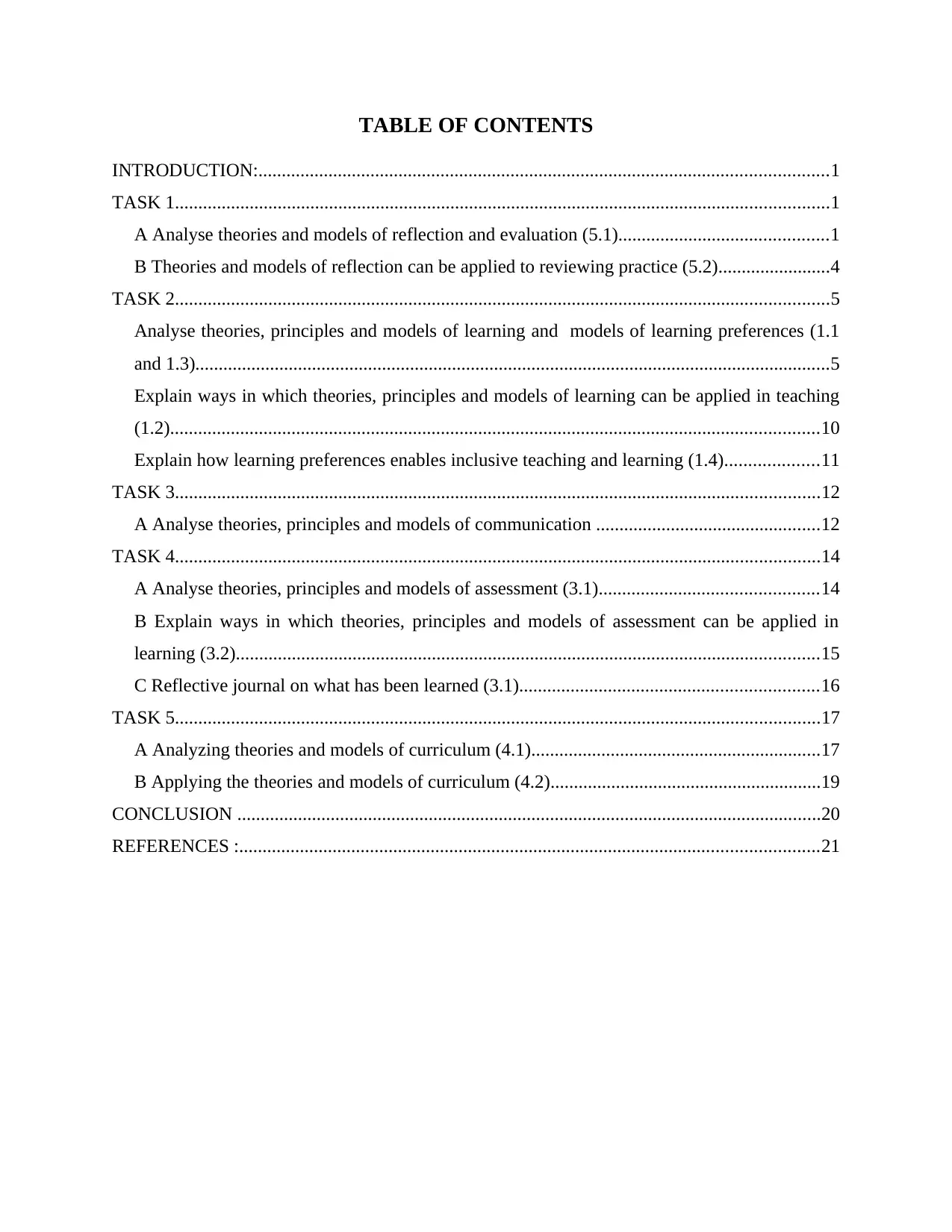
TABLE OF CONTENTS
INTRODUCTION:..........................................................................................................................1
TASK 1............................................................................................................................................1
A Analyse theories and models of reflection and evaluation (5.1).............................................1
B Theories and models of reflection can be applied to reviewing practice (5.2)........................4
TASK 2............................................................................................................................................5
Analyse theories, principles and models of learning and models of learning preferences (1.1
and 1.3)........................................................................................................................................5
Explain ways in which theories, principles and models of learning can be applied in teaching
(1.2)...........................................................................................................................................10
Explain how learning preferences enables inclusive teaching and learning (1.4)....................11
TASK 3..........................................................................................................................................12
A Analyse theories, principles and models of communication ................................................12
TASK 4..........................................................................................................................................14
A Analyse theories, principles and models of assessment (3.1)...............................................14
B Explain ways in which theories, principles and models of assessment can be applied in
learning (3.2).............................................................................................................................15
C Reflective journal on what has been learned (3.1)................................................................16
TASK 5..........................................................................................................................................17
A Analyzing theories and models of curriculum (4.1)..............................................................17
B Applying the theories and models of curriculum (4.2)..........................................................19
CONCLUSION .............................................................................................................................20
REFERENCES :............................................................................................................................21
INTRODUCTION:..........................................................................................................................1
TASK 1............................................................................................................................................1
A Analyse theories and models of reflection and evaluation (5.1).............................................1
B Theories and models of reflection can be applied to reviewing practice (5.2)........................4
TASK 2............................................................................................................................................5
Analyse theories, principles and models of learning and models of learning preferences (1.1
and 1.3)........................................................................................................................................5
Explain ways in which theories, principles and models of learning can be applied in teaching
(1.2)...........................................................................................................................................10
Explain how learning preferences enables inclusive teaching and learning (1.4)....................11
TASK 3..........................................................................................................................................12
A Analyse theories, principles and models of communication ................................................12
TASK 4..........................................................................................................................................14
A Analyse theories, principles and models of assessment (3.1)...............................................14
B Explain ways in which theories, principles and models of assessment can be applied in
learning (3.2).............................................................................................................................15
C Reflective journal on what has been learned (3.1)................................................................16
TASK 5..........................................................................................................................................17
A Analyzing theories and models of curriculum (4.1)..............................................................17
B Applying the theories and models of curriculum (4.2)..........................................................19
CONCLUSION .............................................................................................................................20
REFERENCES :............................................................................................................................21
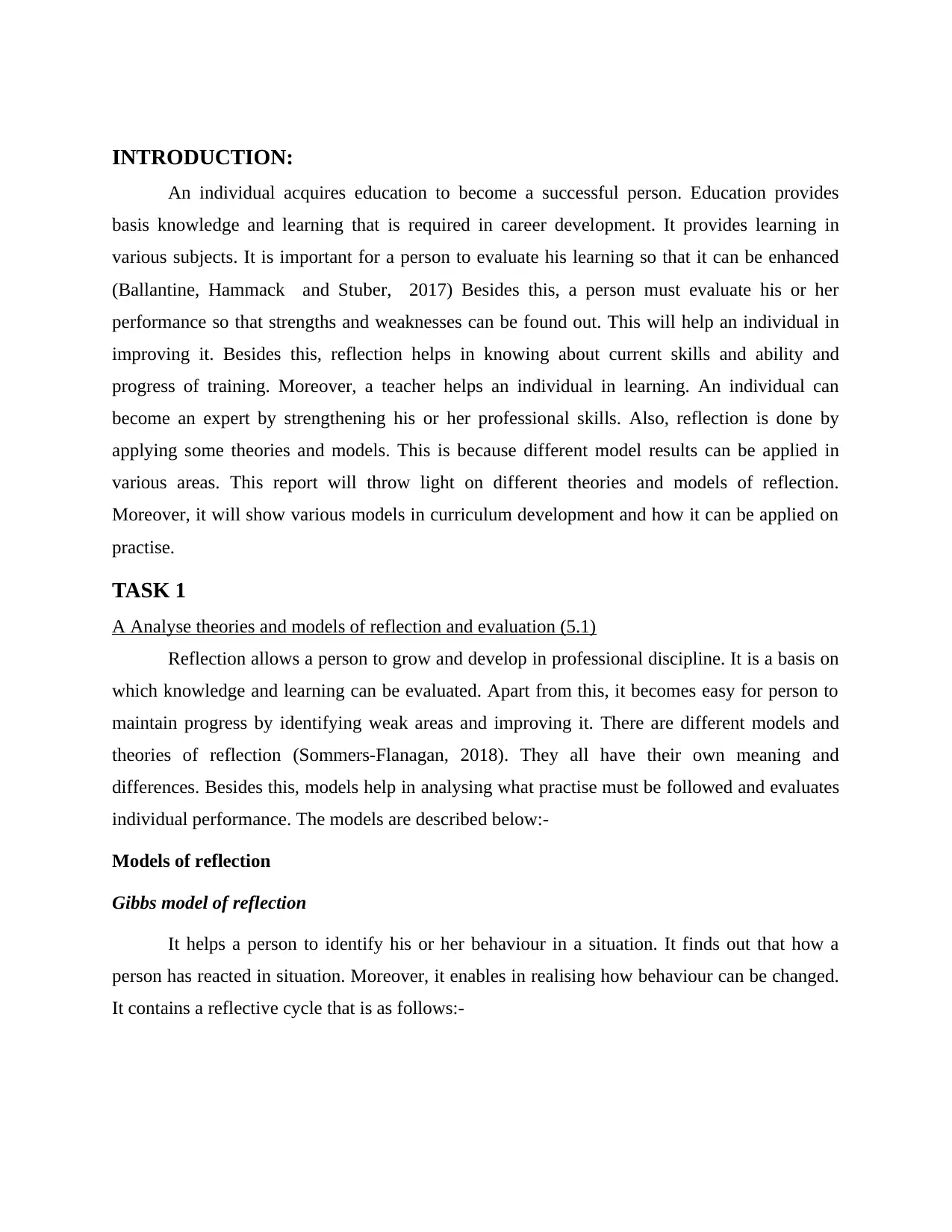
INTRODUCTION:
An individual acquires education to become a successful person. Education provides
basis knowledge and learning that is required in career development. It provides learning in
various subjects. It is important for a person to evaluate his learning so that it can be enhanced
(Ballantine, Hammack and Stuber, 2017) Besides this, a person must evaluate his or her
performance so that strengths and weaknesses can be found out. This will help an individual in
improving it. Besides this, reflection helps in knowing about current skills and ability and
progress of training. Moreover, a teacher helps an individual in learning. An individual can
become an expert by strengthening his or her professional skills. Also, reflection is done by
applying some theories and models. This is because different model results can be applied in
various areas. This report will throw light on different theories and models of reflection.
Moreover, it will show various models in curriculum development and how it can be applied on
practise.
TASK 1
A Analyse theories and models of reflection and evaluation (5.1)
Reflection allows a person to grow and develop in professional discipline. It is a basis on
which knowledge and learning can be evaluated. Apart from this, it becomes easy for person to
maintain progress by identifying weak areas and improving it. There are different models and
theories of reflection (Sommers-Flanagan, 2018). They all have their own meaning and
differences. Besides this, models help in analysing what practise must be followed and evaluates
individual performance. The models are described below:-
Models of reflection
Gibbs model of reflection
It helps a person to identify his or her behaviour in a situation. It finds out that how a
person has reacted in situation. Moreover, it enables in realising how behaviour can be changed.
It contains a reflective cycle that is as follows:-
An individual acquires education to become a successful person. Education provides
basis knowledge and learning that is required in career development. It provides learning in
various subjects. It is important for a person to evaluate his learning so that it can be enhanced
(Ballantine, Hammack and Stuber, 2017) Besides this, a person must evaluate his or her
performance so that strengths and weaknesses can be found out. This will help an individual in
improving it. Besides this, reflection helps in knowing about current skills and ability and
progress of training. Moreover, a teacher helps an individual in learning. An individual can
become an expert by strengthening his or her professional skills. Also, reflection is done by
applying some theories and models. This is because different model results can be applied in
various areas. This report will throw light on different theories and models of reflection.
Moreover, it will show various models in curriculum development and how it can be applied on
practise.
TASK 1
A Analyse theories and models of reflection and evaluation (5.1)
Reflection allows a person to grow and develop in professional discipline. It is a basis on
which knowledge and learning can be evaluated. Apart from this, it becomes easy for person to
maintain progress by identifying weak areas and improving it. There are different models and
theories of reflection (Sommers-Flanagan, 2018). They all have their own meaning and
differences. Besides this, models help in analysing what practise must be followed and evaluates
individual performance. The models are described below:-
Models of reflection
Gibbs model of reflection
It helps a person to identify his or her behaviour in a situation. It finds out that how a
person has reacted in situation. Moreover, it enables in realising how behaviour can be changed.
It contains a reflective cycle that is as follows:-
⊘ This is a preview!⊘
Do you want full access?
Subscribe today to unlock all pages.

Trusted by 1+ million students worldwide
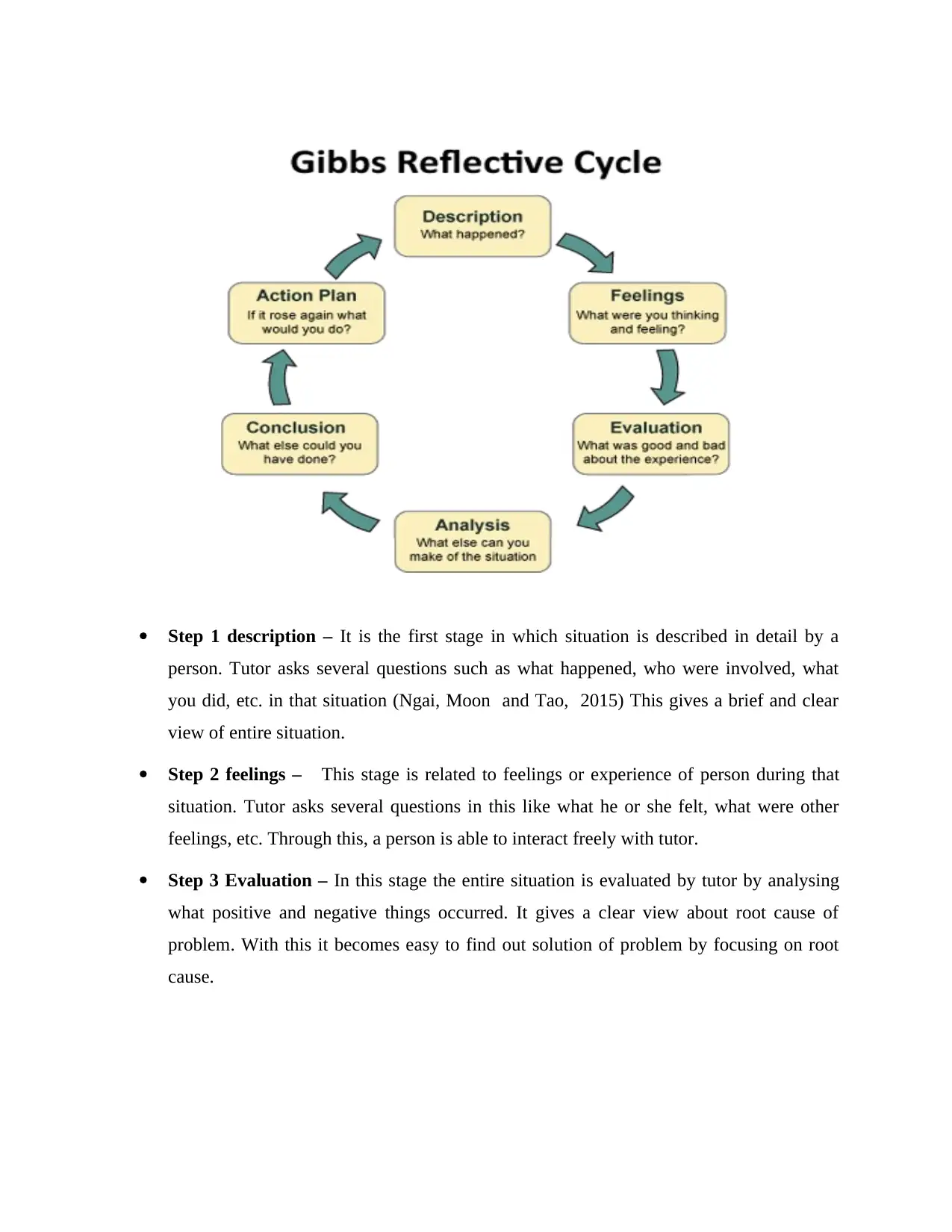
Step 1 description – It is the first stage in which situation is described in detail by a
person. Tutor asks several questions such as what happened, who were involved, what
you did, etc. in that situation (Ngai, Moon and Tao, 2015) This gives a brief and clear
view of entire situation.
Step 2 feelings – This stage is related to feelings or experience of person during that
situation. Tutor asks several questions in this like what he or she felt, what were other
feelings, etc. Through this, a person is able to interact freely with tutor.
Step 3 Evaluation – In this stage the entire situation is evaluated by tutor by analysing
what positive and negative things occurred. It gives a clear view about root cause of
problem. With this it becomes easy to find out solution of problem by focusing on root
cause.
person. Tutor asks several questions such as what happened, who were involved, what
you did, etc. in that situation (Ngai, Moon and Tao, 2015) This gives a brief and clear
view of entire situation.
Step 2 feelings – This stage is related to feelings or experience of person during that
situation. Tutor asks several questions in this like what he or she felt, what were other
feelings, etc. Through this, a person is able to interact freely with tutor.
Step 3 Evaluation – In this stage the entire situation is evaluated by tutor by analysing
what positive and negative things occurred. It gives a clear view about root cause of
problem. With this it becomes easy to find out solution of problem by focusing on root
cause.
Paraphrase This Document
Need a fresh take? Get an instant paraphrase of this document with our AI Paraphraser
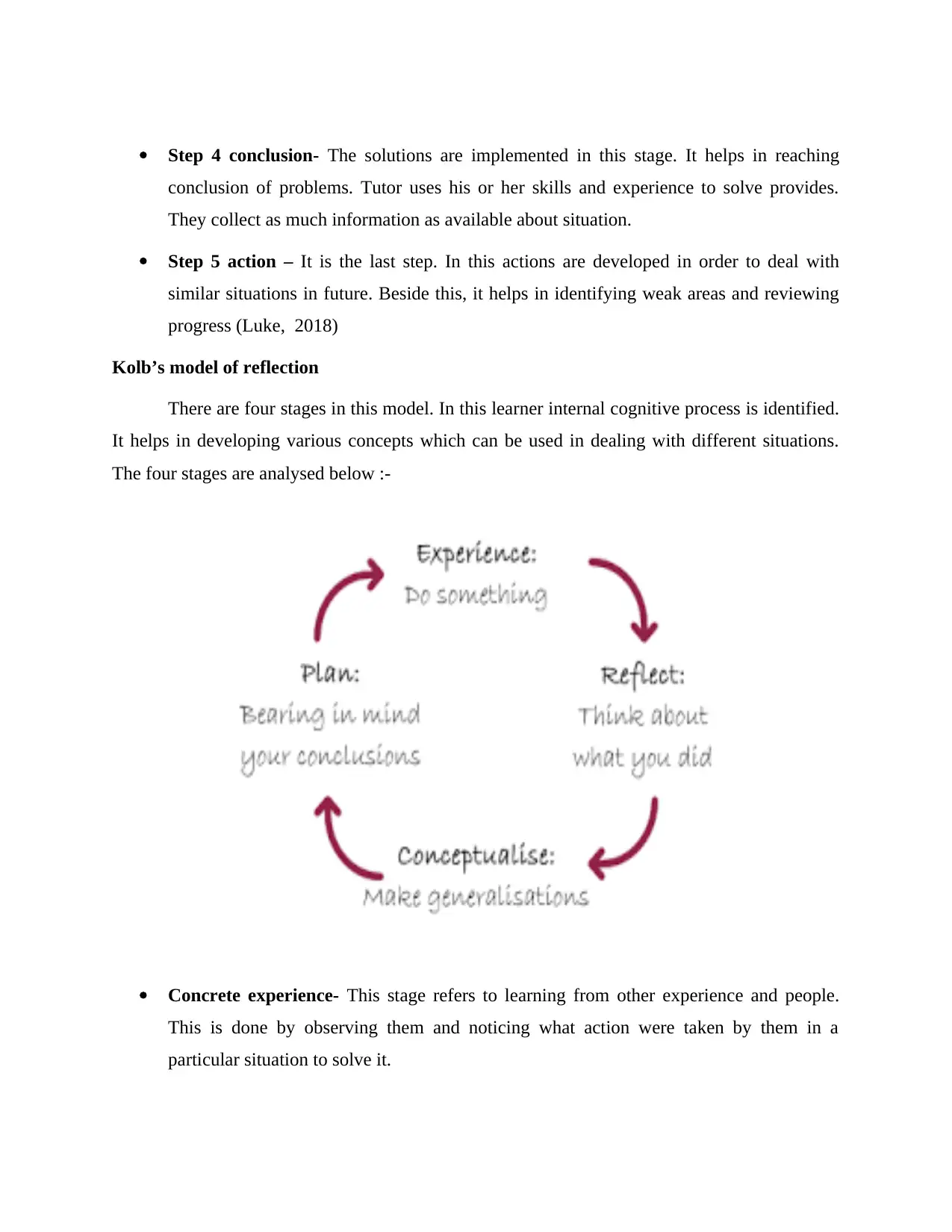
Step 4 conclusion- The solutions are implemented in this stage. It helps in reaching
conclusion of problems. Tutor uses his or her skills and experience to solve provides.
They collect as much information as available about situation.
Step 5 action – It is the last step. In this actions are developed in order to deal with
similar situations in future. Beside this, it helps in identifying weak areas and reviewing
progress (Luke, 2018)
Kolb’s model of reflection
There are four stages in this model. In this learner internal cognitive process is identified.
It helps in developing various concepts which can be used in dealing with different situations.
The four stages are analysed below :-
Concrete experience- This stage refers to learning from other experience and people.
This is done by observing them and noticing what action were taken by them in a
particular situation to solve it.
conclusion of problems. Tutor uses his or her skills and experience to solve provides.
They collect as much information as available about situation.
Step 5 action – It is the last step. In this actions are developed in order to deal with
similar situations in future. Beside this, it helps in identifying weak areas and reviewing
progress (Luke, 2018)
Kolb’s model of reflection
There are four stages in this model. In this learner internal cognitive process is identified.
It helps in developing various concepts which can be used in dealing with different situations.
The four stages are analysed below :-
Concrete experience- This stage refers to learning from other experience and people.
This is done by observing them and noticing what action were taken by them in a
particular situation to solve it.
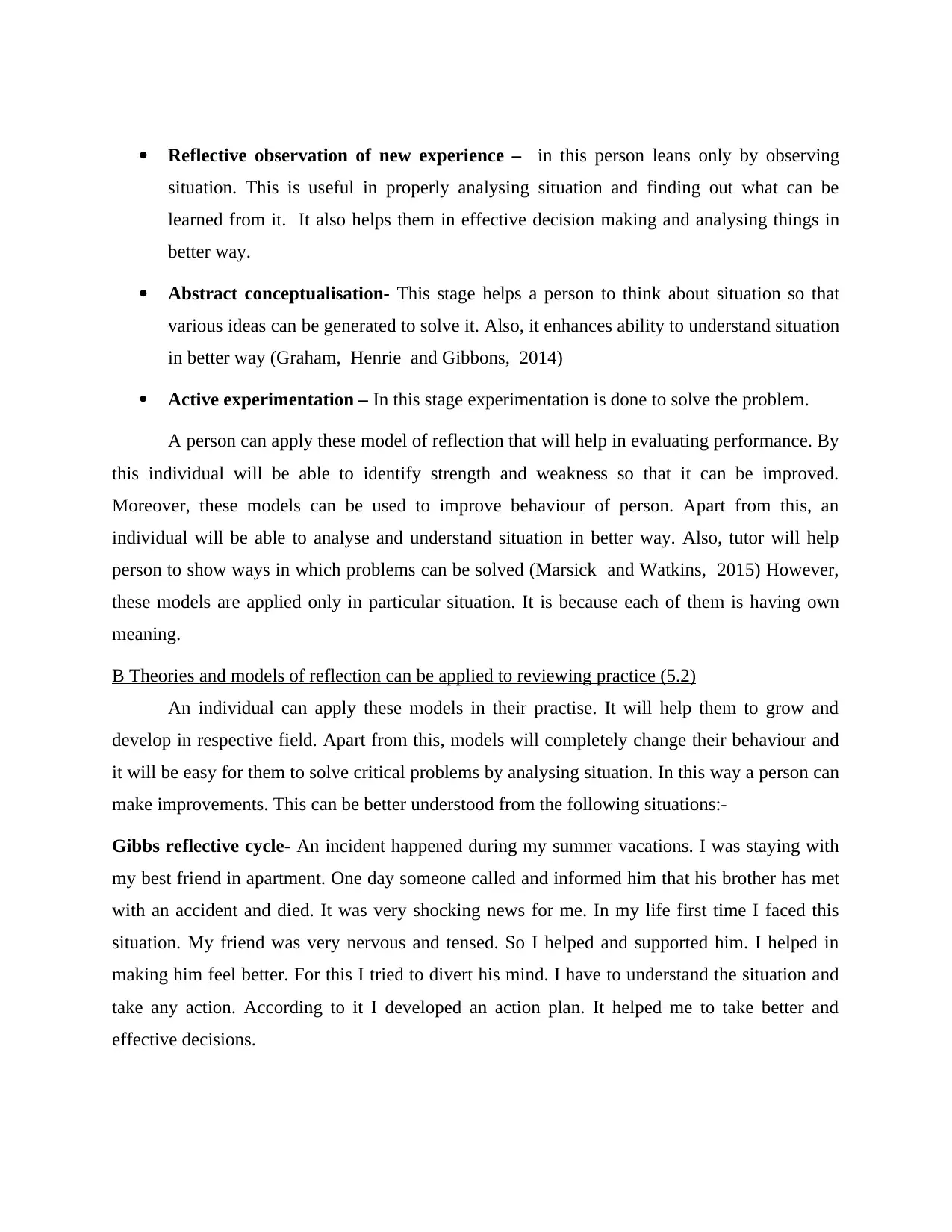
Reflective observation of new experience – in this person leans only by observing
situation. This is useful in properly analysing situation and finding out what can be
learned from it. It also helps them in effective decision making and analysing things in
better way.
Abstract conceptualisation- This stage helps a person to think about situation so that
various ideas can be generated to solve it. Also, it enhances ability to understand situation
in better way (Graham, Henrie and Gibbons, 2014)
Active experimentation – In this stage experimentation is done to solve the problem.
A person can apply these model of reflection that will help in evaluating performance. By
this individual will be able to identify strength and weakness so that it can be improved.
Moreover, these models can be used to improve behaviour of person. Apart from this, an
individual will be able to analyse and understand situation in better way. Also, tutor will help
person to show ways in which problems can be solved (Marsick and Watkins, 2015) However,
these models are applied only in particular situation. It is because each of them is having own
meaning.
B Theories and models of reflection can be applied to reviewing practice (5.2)
An individual can apply these models in their practise. It will help them to grow and
develop in respective field. Apart from this, models will completely change their behaviour and
it will be easy for them to solve critical problems by analysing situation. In this way a person can
make improvements. This can be better understood from the following situations:-
Gibbs reflective cycle- An incident happened during my summer vacations. I was staying with
my best friend in apartment. One day someone called and informed him that his brother has met
with an accident and died. It was very shocking news for me. In my life first time I faced this
situation. My friend was very nervous and tensed. So I helped and supported him. I helped in
making him feel better. For this I tried to divert his mind. I have to understand the situation and
take any action. According to it I developed an action plan. It helped me to take better and
effective decisions.
situation. This is useful in properly analysing situation and finding out what can be
learned from it. It also helps them in effective decision making and analysing things in
better way.
Abstract conceptualisation- This stage helps a person to think about situation so that
various ideas can be generated to solve it. Also, it enhances ability to understand situation
in better way (Graham, Henrie and Gibbons, 2014)
Active experimentation – In this stage experimentation is done to solve the problem.
A person can apply these model of reflection that will help in evaluating performance. By
this individual will be able to identify strength and weakness so that it can be improved.
Moreover, these models can be used to improve behaviour of person. Apart from this, an
individual will be able to analyse and understand situation in better way. Also, tutor will help
person to show ways in which problems can be solved (Marsick and Watkins, 2015) However,
these models are applied only in particular situation. It is because each of them is having own
meaning.
B Theories and models of reflection can be applied to reviewing practice (5.2)
An individual can apply these models in their practise. It will help them to grow and
develop in respective field. Apart from this, models will completely change their behaviour and
it will be easy for them to solve critical problems by analysing situation. In this way a person can
make improvements. This can be better understood from the following situations:-
Gibbs reflective cycle- An incident happened during my summer vacations. I was staying with
my best friend in apartment. One day someone called and informed him that his brother has met
with an accident and died. It was very shocking news for me. In my life first time I faced this
situation. My friend was very nervous and tensed. So I helped and supported him. I helped in
making him feel better. For this I tried to divert his mind. I have to understand the situation and
take any action. According to it I developed an action plan. It helped me to take better and
effective decisions.
⊘ This is a preview!⊘
Do you want full access?
Subscribe today to unlock all pages.

Trusted by 1+ million students worldwide
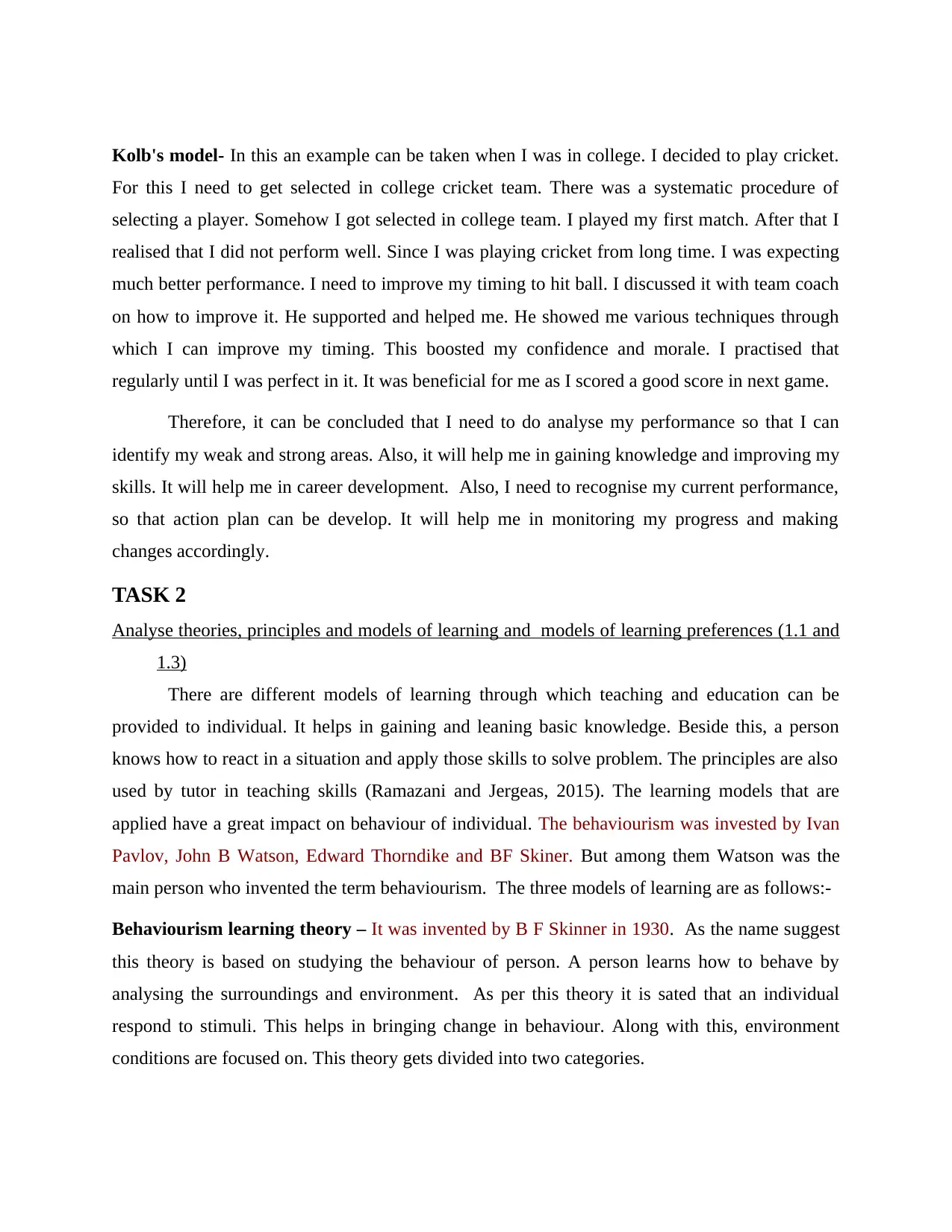
Kolb's model- In this an example can be taken when I was in college. I decided to play cricket.
For this I need to get selected in college cricket team. There was a systematic procedure of
selecting a player. Somehow I got selected in college team. I played my first match. After that I
realised that I did not perform well. Since I was playing cricket from long time. I was expecting
much better performance. I need to improve my timing to hit ball. I discussed it with team coach
on how to improve it. He supported and helped me. He showed me various techniques through
which I can improve my timing. This boosted my confidence and morale. I practised that
regularly until I was perfect in it. It was beneficial for me as I scored a good score in next game.
Therefore, it can be concluded that I need to do analyse my performance so that I can
identify my weak and strong areas. Also, it will help me in gaining knowledge and improving my
skills. It will help me in career development. Also, I need to recognise my current performance,
so that action plan can be develop. It will help me in monitoring my progress and making
changes accordingly.
TASK 2
Analyse theories, principles and models of learning and models of learning preferences (1.1 and
1.3)
There are different models of learning through which teaching and education can be
provided to individual. It helps in gaining and leaning basic knowledge. Beside this, a person
knows how to react in a situation and apply those skills to solve problem. The principles are also
used by tutor in teaching skills (Ramazani and Jergeas, 2015). The learning models that are
applied have a great impact on behaviour of individual. The behaviourism was invested by Ivan
Pavlov, John B Watson, Edward Thorndike and BF Skiner. But among them Watson was the
main person who invented the term behaviourism. The three models of learning are as follows:-
Behaviourism learning theory – It was invented by B F Skinner in 1930. As the name suggest
this theory is based on studying the behaviour of person. A person learns how to behave by
analysing the surroundings and environment. As per this theory it is sated that an individual
respond to stimuli. This helps in bringing change in behaviour. Along with this, environment
conditions are focused on. This theory gets divided into two categories.
For this I need to get selected in college cricket team. There was a systematic procedure of
selecting a player. Somehow I got selected in college team. I played my first match. After that I
realised that I did not perform well. Since I was playing cricket from long time. I was expecting
much better performance. I need to improve my timing to hit ball. I discussed it with team coach
on how to improve it. He supported and helped me. He showed me various techniques through
which I can improve my timing. This boosted my confidence and morale. I practised that
regularly until I was perfect in it. It was beneficial for me as I scored a good score in next game.
Therefore, it can be concluded that I need to do analyse my performance so that I can
identify my weak and strong areas. Also, it will help me in gaining knowledge and improving my
skills. It will help me in career development. Also, I need to recognise my current performance,
so that action plan can be develop. It will help me in monitoring my progress and making
changes accordingly.
TASK 2
Analyse theories, principles and models of learning and models of learning preferences (1.1 and
1.3)
There are different models of learning through which teaching and education can be
provided to individual. It helps in gaining and leaning basic knowledge. Beside this, a person
knows how to react in a situation and apply those skills to solve problem. The principles are also
used by tutor in teaching skills (Ramazani and Jergeas, 2015). The learning models that are
applied have a great impact on behaviour of individual. The behaviourism was invested by Ivan
Pavlov, John B Watson, Edward Thorndike and BF Skiner. But among them Watson was the
main person who invented the term behaviourism. The three models of learning are as follows:-
Behaviourism learning theory – It was invented by B F Skinner in 1930. As the name suggest
this theory is based on studying the behaviour of person. A person learns how to behave by
analysing the surroundings and environment. As per this theory it is sated that an individual
respond to stimuli. This helps in bringing change in behaviour. Along with this, environment
conditions are focused on. This theory gets divided into two categories.
Paraphrase This Document
Need a fresh take? Get an instant paraphrase of this document with our AI Paraphraser
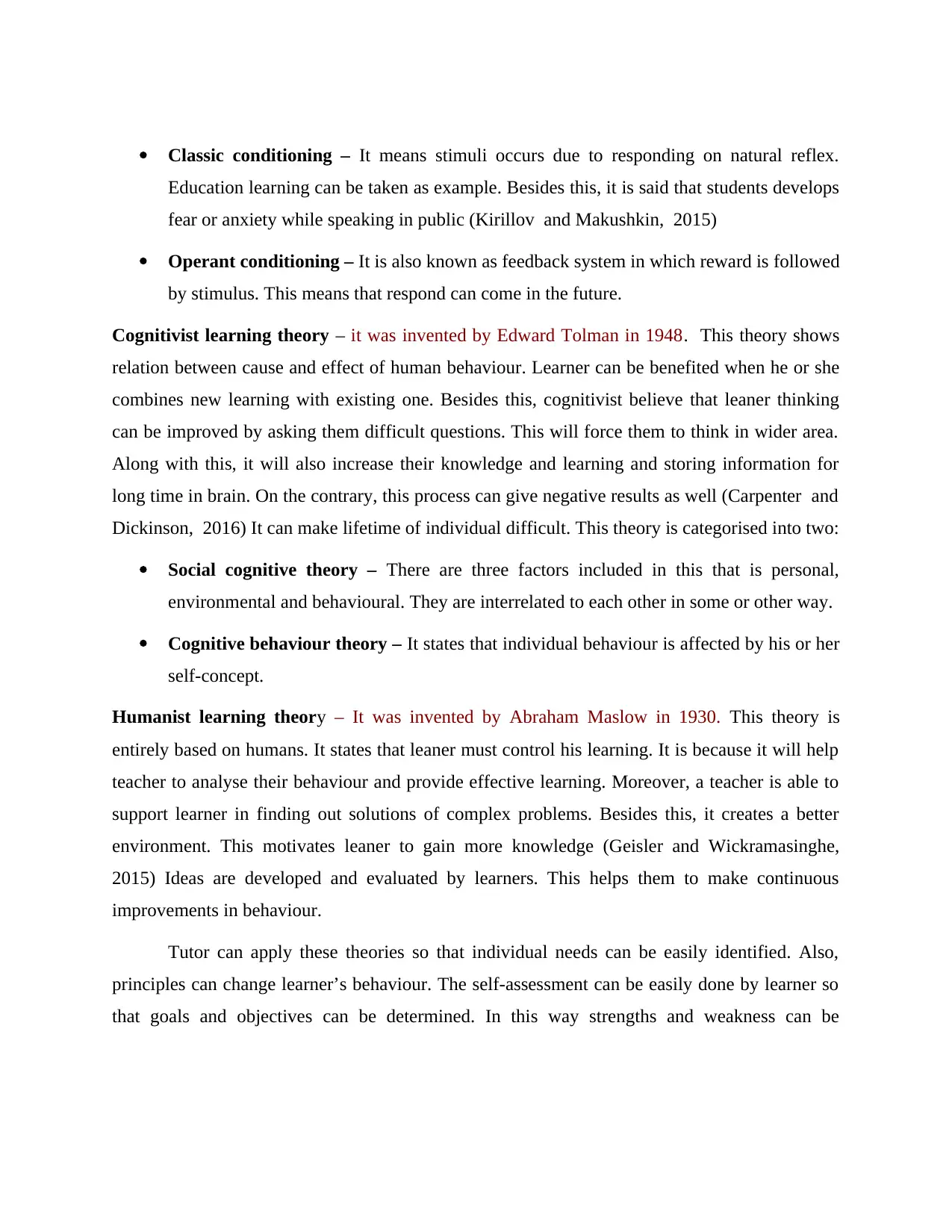
Classic conditioning – It means stimuli occurs due to responding on natural reflex.
Education learning can be taken as example. Besides this, it is said that students develops
fear or anxiety while speaking in public (Kirillov and Makushkin, 2015)
Operant conditioning – It is also known as feedback system in which reward is followed
by stimulus. This means that respond can come in the future.
Cognitivist learning theory – it was invented by Edward Tolman in 1948. This theory shows
relation between cause and effect of human behaviour. Learner can be benefited when he or she
combines new learning with existing one. Besides this, cognitivist believe that leaner thinking
can be improved by asking them difficult questions. This will force them to think in wider area.
Along with this, it will also increase their knowledge and learning and storing information for
long time in brain. On the contrary, this process can give negative results as well (Carpenter and
Dickinson, 2016) It can make lifetime of individual difficult. This theory is categorised into two:
Social cognitive theory – There are three factors included in this that is personal,
environmental and behavioural. They are interrelated to each other in some or other way.
Cognitive behaviour theory – It states that individual behaviour is affected by his or her
self-concept.
Humanist learning theory – It was invented by Abraham Maslow in 1930. This theory is
entirely based on humans. It states that leaner must control his learning. It is because it will help
teacher to analyse their behaviour and provide effective learning. Moreover, a teacher is able to
support learner in finding out solutions of complex problems. Besides this, it creates a better
environment. This motivates leaner to gain more knowledge (Geisler and Wickramasinghe,
2015) Ideas are developed and evaluated by learners. This helps them to make continuous
improvements in behaviour.
Tutor can apply these theories so that individual needs can be easily identified. Also,
principles can change learner’s behaviour. The self-assessment can be easily done by learner so
that goals and objectives can be determined. In this way strengths and weakness can be
Education learning can be taken as example. Besides this, it is said that students develops
fear or anxiety while speaking in public (Kirillov and Makushkin, 2015)
Operant conditioning – It is also known as feedback system in which reward is followed
by stimulus. This means that respond can come in the future.
Cognitivist learning theory – it was invented by Edward Tolman in 1948. This theory shows
relation between cause and effect of human behaviour. Learner can be benefited when he or she
combines new learning with existing one. Besides this, cognitivist believe that leaner thinking
can be improved by asking them difficult questions. This will force them to think in wider area.
Along with this, it will also increase their knowledge and learning and storing information for
long time in brain. On the contrary, this process can give negative results as well (Carpenter and
Dickinson, 2016) It can make lifetime of individual difficult. This theory is categorised into two:
Social cognitive theory – There are three factors included in this that is personal,
environmental and behavioural. They are interrelated to each other in some or other way.
Cognitive behaviour theory – It states that individual behaviour is affected by his or her
self-concept.
Humanist learning theory – It was invented by Abraham Maslow in 1930. This theory is
entirely based on humans. It states that leaner must control his learning. It is because it will help
teacher to analyse their behaviour and provide effective learning. Moreover, a teacher is able to
support learner in finding out solutions of complex problems. Besides this, it creates a better
environment. This motivates leaner to gain more knowledge (Geisler and Wickramasinghe,
2015) Ideas are developed and evaluated by learners. This helps them to make continuous
improvements in behaviour.
Tutor can apply these theories so that individual needs can be easily identified. Also,
principles can change learner’s behaviour. The self-assessment can be easily done by learner so
that goals and objectives can be determined. In this way strengths and weakness can be
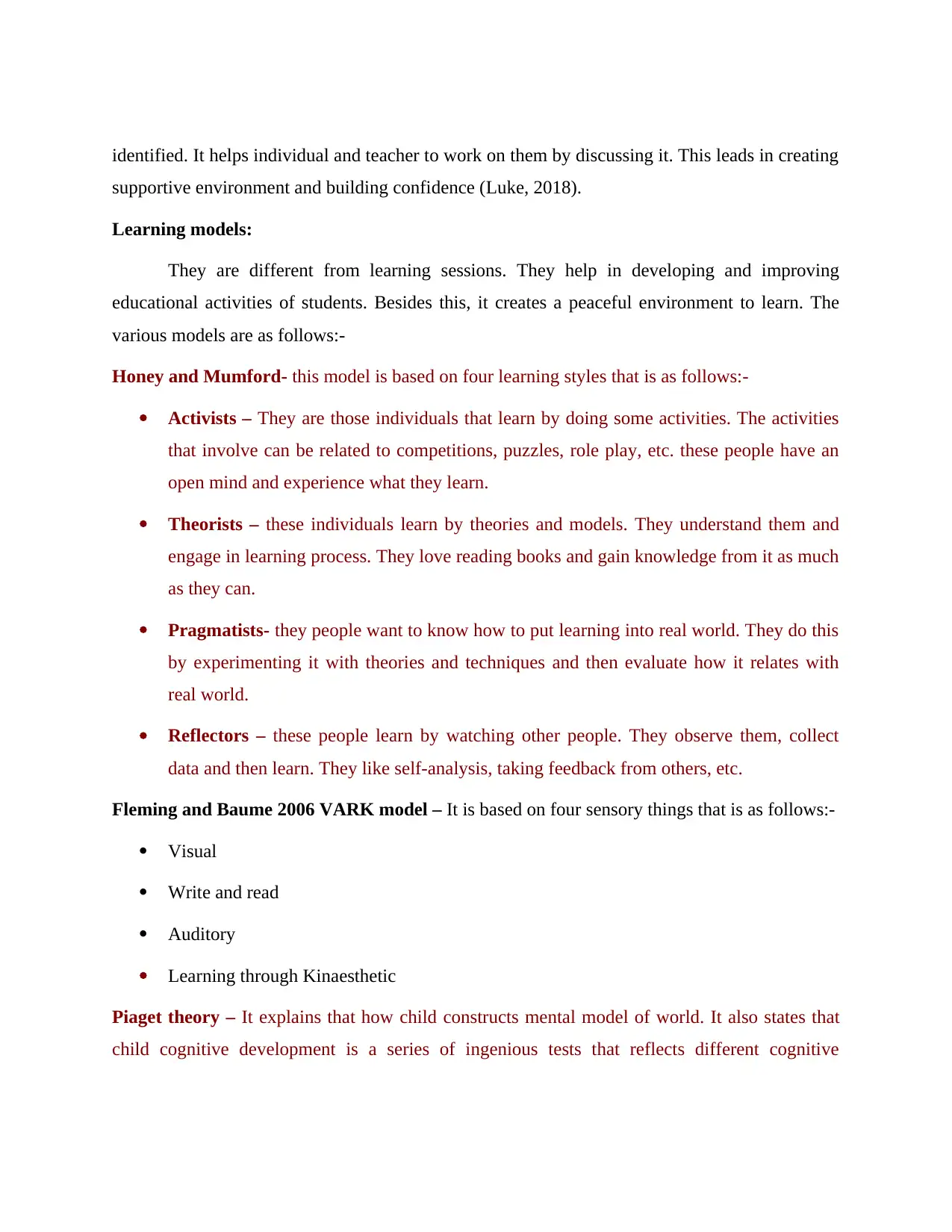
identified. It helps individual and teacher to work on them by discussing it. This leads in creating
supportive environment and building confidence (Luke, 2018).
Learning models:
They are different from learning sessions. They help in developing and improving
educational activities of students. Besides this, it creates a peaceful environment to learn. The
various models are as follows:-
Honey and Mumford- this model is based on four learning styles that is as follows:-
Activists – They are those individuals that learn by doing some activities. The activities
that involve can be related to competitions, puzzles, role play, etc. these people have an
open mind and experience what they learn.
Theorists – these individuals learn by theories and models. They understand them and
engage in learning process. They love reading books and gain knowledge from it as much
as they can.
Pragmatists- they people want to know how to put learning into real world. They do this
by experimenting it with theories and techniques and then evaluate how it relates with
real world.
Reflectors – these people learn by watching other people. They observe them, collect
data and then learn. They like self-analysis, taking feedback from others, etc.
Fleming and Baume 2006 VARK model – It is based on four sensory things that is as follows:-
Visual
Write and read
Auditory
Learning through Kinaesthetic
Piaget theory – It explains that how child constructs mental model of world. It also states that
child cognitive development is a series of ingenious tests that reflects different cognitive
supportive environment and building confidence (Luke, 2018).
Learning models:
They are different from learning sessions. They help in developing and improving
educational activities of students. Besides this, it creates a peaceful environment to learn. The
various models are as follows:-
Honey and Mumford- this model is based on four learning styles that is as follows:-
Activists – They are those individuals that learn by doing some activities. The activities
that involve can be related to competitions, puzzles, role play, etc. these people have an
open mind and experience what they learn.
Theorists – these individuals learn by theories and models. They understand them and
engage in learning process. They love reading books and gain knowledge from it as much
as they can.
Pragmatists- they people want to know how to put learning into real world. They do this
by experimenting it with theories and techniques and then evaluate how it relates with
real world.
Reflectors – these people learn by watching other people. They observe them, collect
data and then learn. They like self-analysis, taking feedback from others, etc.
Fleming and Baume 2006 VARK model – It is based on four sensory things that is as follows:-
Visual
Write and read
Auditory
Learning through Kinaesthetic
Piaget theory – It explains that how child constructs mental model of world. It also states that
child cognitive development is a series of ingenious tests that reflects different cognitive
⊘ This is a preview!⊘
Do you want full access?
Subscribe today to unlock all pages.

Trusted by 1+ million students worldwide
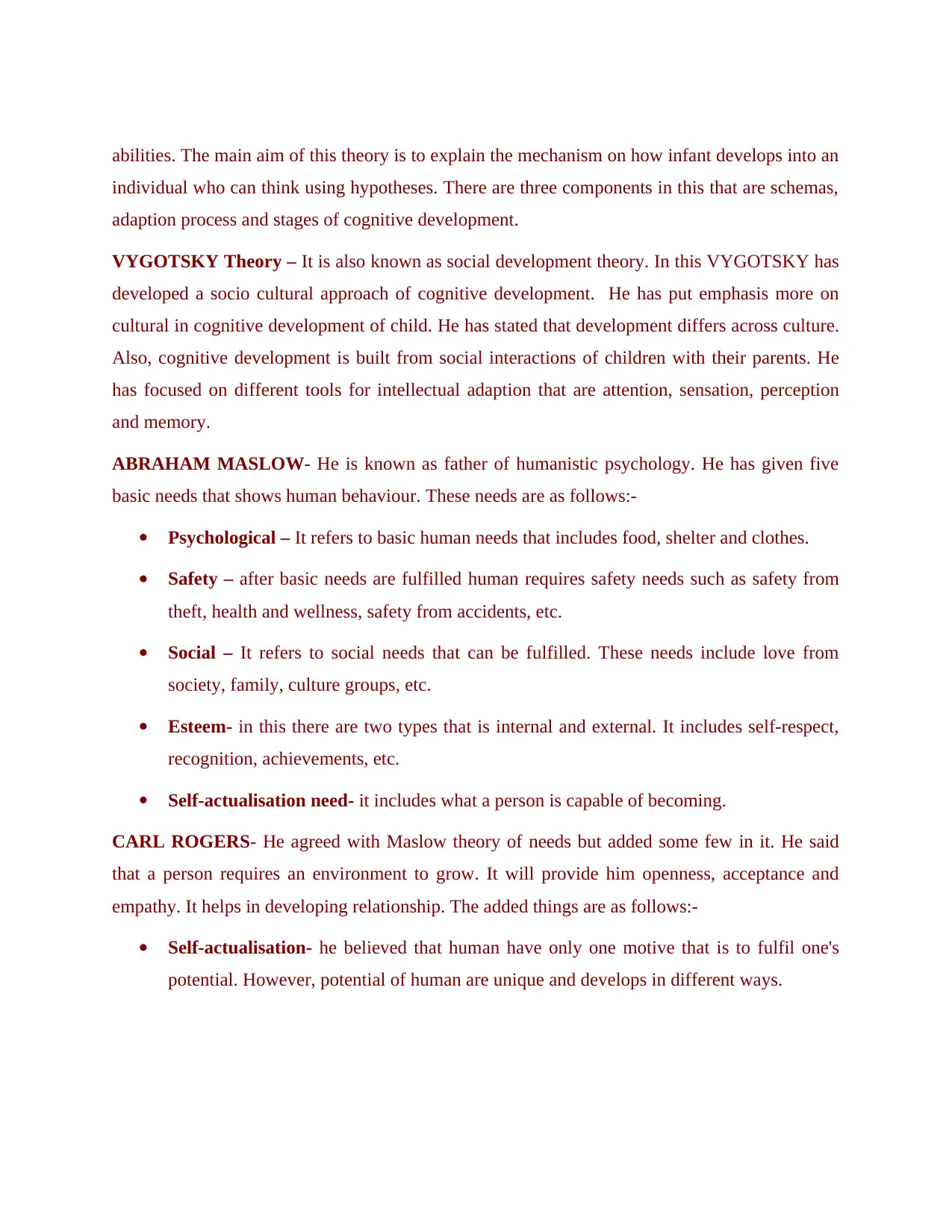
abilities. The main aim of this theory is to explain the mechanism on how infant develops into an
individual who can think using hypotheses. There are three components in this that are schemas,
adaption process and stages of cognitive development.
VYGOTSKY Theory – It is also known as social development theory. In this VYGOTSKY has
developed a socio cultural approach of cognitive development. He has put emphasis more on
cultural in cognitive development of child. He has stated that development differs across culture.
Also, cognitive development is built from social interactions of children with their parents. He
has focused on different tools for intellectual adaption that are attention, sensation, perception
and memory.
ABRAHAM MASLOW- He is known as father of humanistic psychology. He has given five
basic needs that shows human behaviour. These needs are as follows:-
Psychological – It refers to basic human needs that includes food, shelter and clothes.
Safety – after basic needs are fulfilled human requires safety needs such as safety from
theft, health and wellness, safety from accidents, etc.
Social – It refers to social needs that can be fulfilled. These needs include love from
society, family, culture groups, etc.
Esteem- in this there are two types that is internal and external. It includes self-respect,
recognition, achievements, etc.
Self-actualisation need- it includes what a person is capable of becoming.
CARL ROGERS- He agreed with Maslow theory of needs but added some few in it. He said
that a person requires an environment to grow. It will provide him openness, acceptance and
empathy. It helps in developing relationship. The added things are as follows:-
Self-actualisation- he believed that human have only one motive that is to fulfil one's
potential. However, potential of human are unique and develops in different ways.
individual who can think using hypotheses. There are three components in this that are schemas,
adaption process and stages of cognitive development.
VYGOTSKY Theory – It is also known as social development theory. In this VYGOTSKY has
developed a socio cultural approach of cognitive development. He has put emphasis more on
cultural in cognitive development of child. He has stated that development differs across culture.
Also, cognitive development is built from social interactions of children with their parents. He
has focused on different tools for intellectual adaption that are attention, sensation, perception
and memory.
ABRAHAM MASLOW- He is known as father of humanistic psychology. He has given five
basic needs that shows human behaviour. These needs are as follows:-
Psychological – It refers to basic human needs that includes food, shelter and clothes.
Safety – after basic needs are fulfilled human requires safety needs such as safety from
theft, health and wellness, safety from accidents, etc.
Social – It refers to social needs that can be fulfilled. These needs include love from
society, family, culture groups, etc.
Esteem- in this there are two types that is internal and external. It includes self-respect,
recognition, achievements, etc.
Self-actualisation need- it includes what a person is capable of becoming.
CARL ROGERS- He agreed with Maslow theory of needs but added some few in it. He said
that a person requires an environment to grow. It will provide him openness, acceptance and
empathy. It helps in developing relationship. The added things are as follows:-
Self-actualisation- he believed that human have only one motive that is to fulfil one's
potential. However, potential of human are unique and develops in different ways.
Paraphrase This Document
Need a fresh take? Get an instant paraphrase of this document with our AI Paraphraser
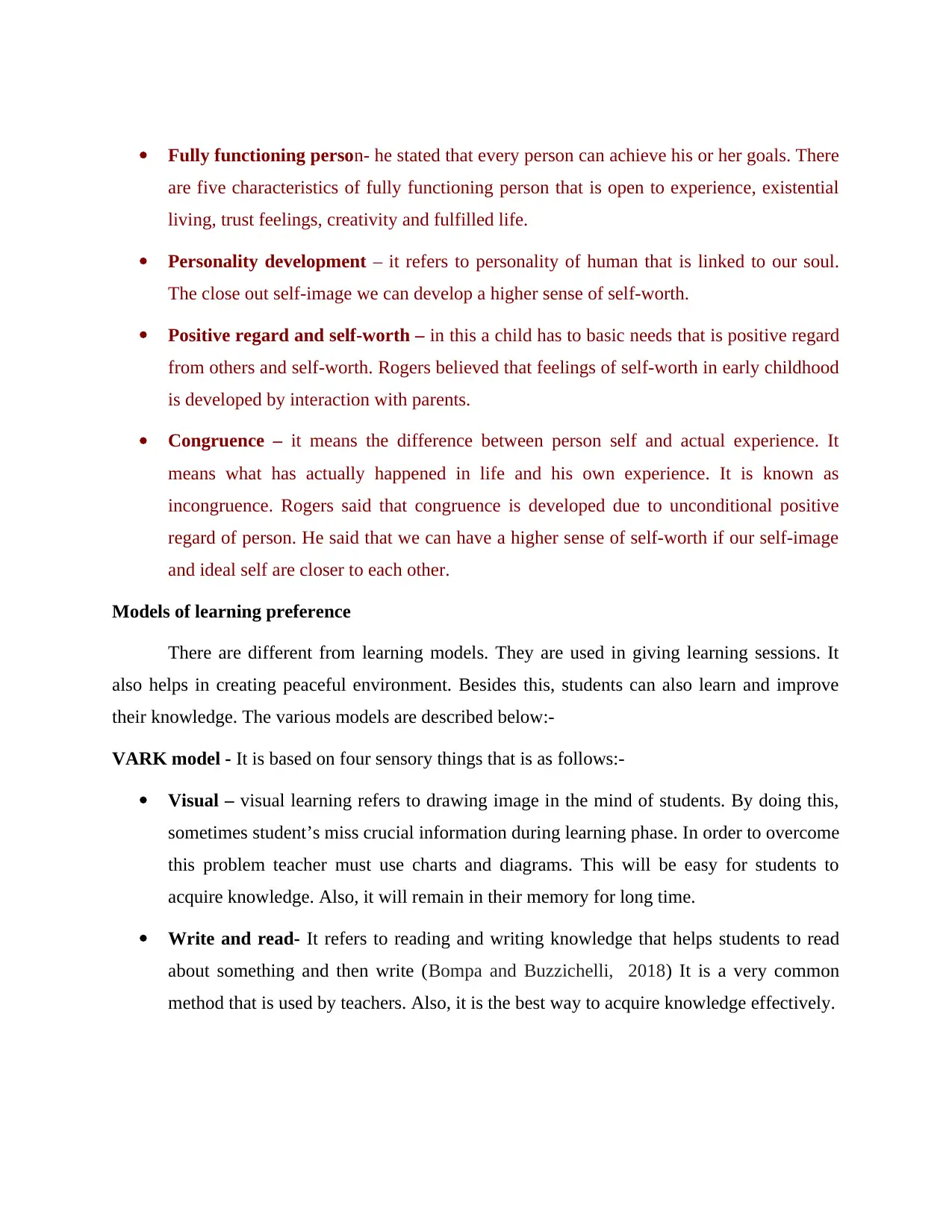
Fully functioning person- he stated that every person can achieve his or her goals. There
are five characteristics of fully functioning person that is open to experience, existential
living, trust feelings, creativity and fulfilled life.
Personality development – it refers to personality of human that is linked to our soul.
The close out self-image we can develop a higher sense of self-worth.
Positive regard and self-worth – in this a child has to basic needs that is positive regard
from others and self-worth. Rogers believed that feelings of self-worth in early childhood
is developed by interaction with parents.
Congruence – it means the difference between person self and actual experience. It
means what has actually happened in life and his own experience. It is known as
incongruence. Rogers said that congruence is developed due to unconditional positive
regard of person. He said that we can have a higher sense of self-worth if our self-image
and ideal self are closer to each other.
Models of learning preference
There are different from learning models. They are used in giving learning sessions. It
also helps in creating peaceful environment. Besides this, students can also learn and improve
their knowledge. The various models are described below:-
VARK model - It is based on four sensory things that is as follows:-
Visual – visual learning refers to drawing image in the mind of students. By doing this,
sometimes student’s miss crucial information during learning phase. In order to overcome
this problem teacher must use charts and diagrams. This will be easy for students to
acquire knowledge. Also, it will remain in their memory for long time.
Write and read- It refers to reading and writing knowledge that helps students to read
about something and then write (Bompa and Buzzichelli, 2018) It is a very common
method that is used by teachers. Also, it is the best way to acquire knowledge effectively.
are five characteristics of fully functioning person that is open to experience, existential
living, trust feelings, creativity and fulfilled life.
Personality development – it refers to personality of human that is linked to our soul.
The close out self-image we can develop a higher sense of self-worth.
Positive regard and self-worth – in this a child has to basic needs that is positive regard
from others and self-worth. Rogers believed that feelings of self-worth in early childhood
is developed by interaction with parents.
Congruence – it means the difference between person self and actual experience. It
means what has actually happened in life and his own experience. It is known as
incongruence. Rogers said that congruence is developed due to unconditional positive
regard of person. He said that we can have a higher sense of self-worth if our self-image
and ideal self are closer to each other.
Models of learning preference
There are different from learning models. They are used in giving learning sessions. It
also helps in creating peaceful environment. Besides this, students can also learn and improve
their knowledge. The various models are described below:-
VARK model - It is based on four sensory things that is as follows:-
Visual – visual learning refers to drawing image in the mind of students. By doing this,
sometimes student’s miss crucial information during learning phase. In order to overcome
this problem teacher must use charts and diagrams. This will be easy for students to
acquire knowledge. Also, it will remain in their memory for long time.
Write and read- It refers to reading and writing knowledge that helps students to read
about something and then write (Bompa and Buzzichelli, 2018) It is a very common
method that is used by teachers. Also, it is the best way to acquire knowledge effectively.
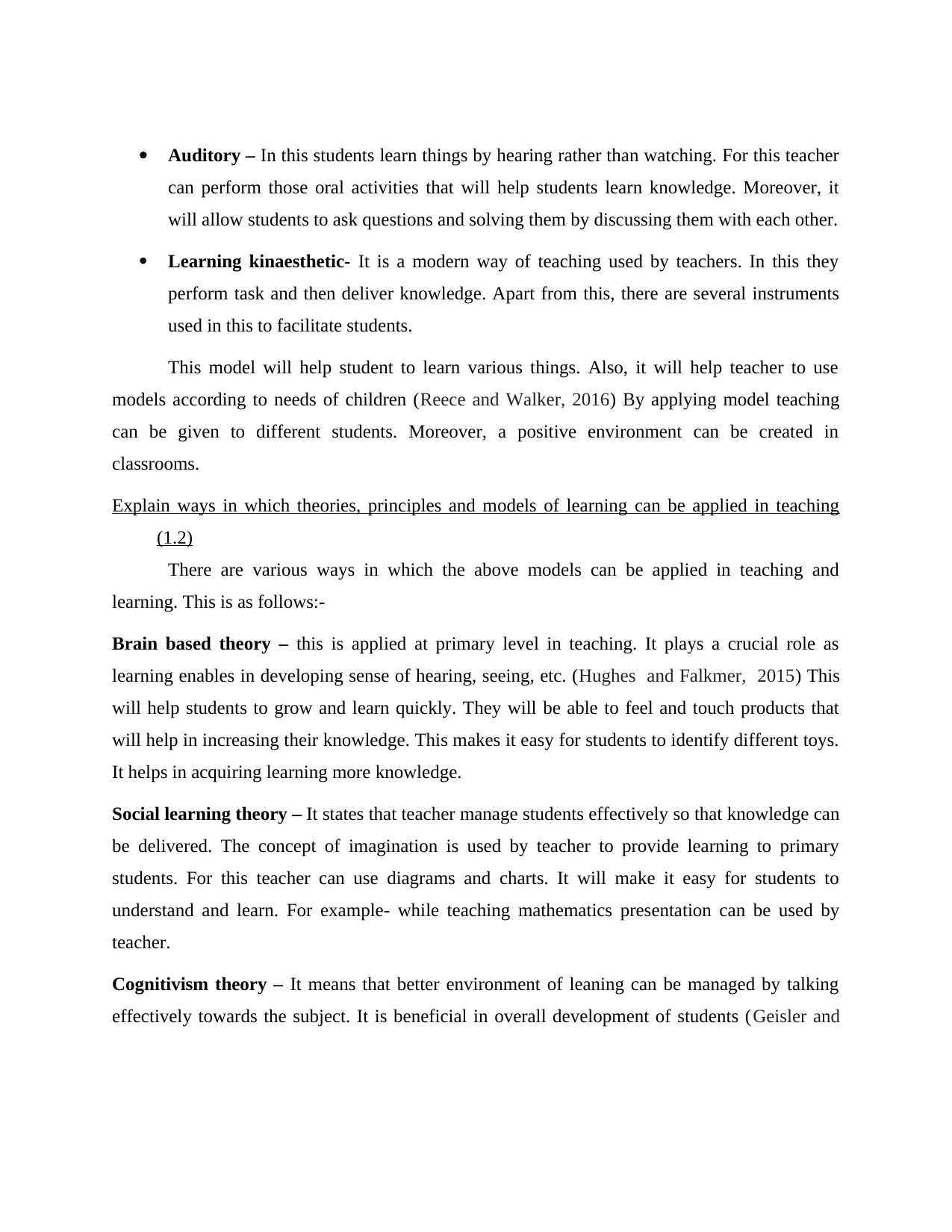
Auditory – In this students learn things by hearing rather than watching. For this teacher
can perform those oral activities that will help students learn knowledge. Moreover, it
will allow students to ask questions and solving them by discussing them with each other.
Learning kinaesthetic- It is a modern way of teaching used by teachers. In this they
perform task and then deliver knowledge. Apart from this, there are several instruments
used in this to facilitate students.
This model will help student to learn various things. Also, it will help teacher to use
models according to needs of children (Reece and Walker, 2016) By applying model teaching
can be given to different students. Moreover, a positive environment can be created in
classrooms.
Explain ways in which theories, principles and models of learning can be applied in teaching
(1.2)
There are various ways in which the above models can be applied in teaching and
learning. This is as follows:-
Brain based theory – this is applied at primary level in teaching. It plays a crucial role as
learning enables in developing sense of hearing, seeing, etc. (Hughes and Falkmer, 2015) This
will help students to grow and learn quickly. They will be able to feel and touch products that
will help in increasing their knowledge. This makes it easy for students to identify different toys.
It helps in acquiring learning more knowledge.
Social learning theory – It states that teacher manage students effectively so that knowledge can
be delivered. The concept of imagination is used by teacher to provide learning to primary
students. For this teacher can use diagrams and charts. It will make it easy for students to
understand and learn. For example- while teaching mathematics presentation can be used by
teacher.
Cognitivism theory – It means that better environment of leaning can be managed by talking
effectively towards the subject. It is beneficial in overall development of students (Geisler and
can perform those oral activities that will help students learn knowledge. Moreover, it
will allow students to ask questions and solving them by discussing them with each other.
Learning kinaesthetic- It is a modern way of teaching used by teachers. In this they
perform task and then deliver knowledge. Apart from this, there are several instruments
used in this to facilitate students.
This model will help student to learn various things. Also, it will help teacher to use
models according to needs of children (Reece and Walker, 2016) By applying model teaching
can be given to different students. Moreover, a positive environment can be created in
classrooms.
Explain ways in which theories, principles and models of learning can be applied in teaching
(1.2)
There are various ways in which the above models can be applied in teaching and
learning. This is as follows:-
Brain based theory – this is applied at primary level in teaching. It plays a crucial role as
learning enables in developing sense of hearing, seeing, etc. (Hughes and Falkmer, 2015) This
will help students to grow and learn quickly. They will be able to feel and touch products that
will help in increasing their knowledge. This makes it easy for students to identify different toys.
It helps in acquiring learning more knowledge.
Social learning theory – It states that teacher manage students effectively so that knowledge can
be delivered. The concept of imagination is used by teacher to provide learning to primary
students. For this teacher can use diagrams and charts. It will make it easy for students to
understand and learn. For example- while teaching mathematics presentation can be used by
teacher.
Cognitivism theory – It means that better environment of leaning can be managed by talking
effectively towards the subject. It is beneficial in overall development of students (Geisler and
⊘ This is a preview!⊘
Do you want full access?
Subscribe today to unlock all pages.

Trusted by 1+ million students worldwide
1 out of 25
Related Documents
Your All-in-One AI-Powered Toolkit for Academic Success.
+13062052269
info@desklib.com
Available 24*7 on WhatsApp / Email
![[object Object]](/_next/static/media/star-bottom.7253800d.svg)
Unlock your academic potential
Copyright © 2020–2025 A2Z Services. All Rights Reserved. Developed and managed by ZUCOL.




